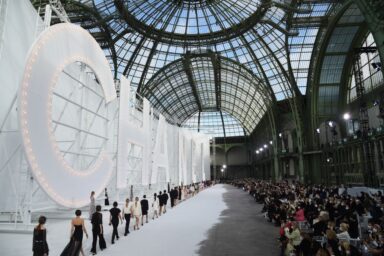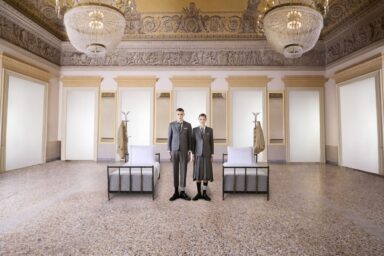PIETRO FADDA IS 2019 ISTITUTO MARANGONI’S BEST DESIGNER. HERE’S OUR INTERVIEW WITH THE YOUNG TALENT: A PASSIONATE OF ESSENTIALITY, ANTI-CONSUMERISTIC, FASCINATED BY 60S-70S ERA AND EAGER TO RE-FIND THE BEAUTY OF CULTURAL RECKLESSNESS
Interview and translation by: Fiammetta Cesana
Founded in 1935 by Giulio Marangoni, the Istituto Marangoni, now established in eight cities worldwide – Milan, Florence, Paris, London, Mumbai, Shanghai, Shenzhen and Miami – is internationally recognized as leader in higher education of fashion, art and design. Every year each school nominates the best designer, and for 2019 the award in Milan has been won by Pietro Fadda, a twenty-year-old Sardinian guy, who presented his “Nextodus – a modern tale of escape” collection.
Let’s find out more about the designer and his vision of fashion between contemporaneity and the 60s-70s…

Ciao Pietro, I’m very intrigued by your collection, winner of the 2019 Milan’s Istituto Marangoni award…
I am so glad! My goal in the creative process is just trying to propose a product that can be original and interesting. In this sense, Istituto Marangoni’s “Fashion Design Collection of the Year” award was certainly a great satisfaction and a crowning achievement for all the efforts of an intense year of work.
Your “Nextodus – a modern tale of escape” collection, just from the title, evokes a precise but at the same time enigmatic message. You took the high school diploma in classical studies, so I guess that “nextodus” embraces the Greek suffix, so meaning something like “next road”… where do you want to guide us with your clothes?
Exactly, the name of the collection comes from the combination of the English word “next” with the Greek origin’s term “exodus, οδος”, seen in its most etymological meaning ἐξ “outside” and ὁδός “road, course”, or a voluntary departure path. In particular, I mean getting away and taking a position on the production of contemporary fashion (and of industrial and cultural products in general) aimed at an extreme and frivolous consumerism. With my collection I want to carry on a multi-functionality and versatility discourse, making sure that through simple elements such as buttons, zip and drawstring you can change the garment’s fit or assemble them in various ways. In doing so, I would like to create clothes that have multiple uses and as many ways of being worn, in a certain sense extending the “life” of the garments themselves, which too often today are conceived as “disposable”.
The theme of escapism. Do you think fashion can be a form of escape?
I think that fashion, like any other artistic product, can give the opportunity to dream and be transported to other realities, other contexts and other places based on the will of those who create it and the sensitivity of those who receive it. At the same time, I am sure that fashion should not act as a mere temporary or frivolous relief from everyday life, I believe it is indeed the duty of every designer to face and reflect in their creations the reality, analyzing it and conveying constructive messages on how to deal with it.
Your heterogeneous outfits cannot help but making me think of what Alessandro Michele calls Don Quixote-like eclecticism. Is Gucci one of your inspirational brands?
I believe that the concept behind Alessandro Michele’s style and his unconventional method of structuring a collection have profoundly revolutionized today’s fashion trends, being able to create a sort of standard, aesthetically so effective, that cannot be ignored by anyone who makes fashion in 2019. That said, by designing “Nextodus” I set the goal of letting myself be influenced as little as possible by what I saw on the catwalks, in order to create a collection that looked directly at the radical Italian design of the late 1960s and was at the same time extremely personal. If I have to mention the brands that inspired me the most in my aesthetics, I would surely name Marni, Maison Margiela and Walter Van Beirendonck.
Your clothes in fact are inspired by the 60s and 70s, an era that obviously, since your splendid youth, you have not lived. What brings you back to those years?
What I appreciate and admire from the period between the end of the 1960s and the beginning of the 1970s, although it is certainly a controversial historical moment, is the concept of freedom. I think that in those years we have reached a level of experimentation, originality and the break of barriers in music (just think of progressive rock and psychedelic rock), in design (just think of radical design movements) and in culture in general, that have ever seen before and that unfortunately remained unrivaled. I acknowledge that history has a cyclical structure and that it is therefore an inevitable process, but I think it is a real pity that this spirit of rebellion and “cultural recklessness” has been lost in the following decades, and that, contrary, an opposite conservative tendency has been generated.
Let’s talk about paradise, about artificial Eden… how does your collection want to recreate a new-primordial community where relationships are, finally, sincere again?
For the concept of “artificial Eden” I was inspired by the “No Stop City” by Archizoom Associates. Conceived between 1968 and 1971, it represented their first project for a city of the future, which consisted of a space without boundaries, homogeneous, utilitarian and functional, designed on the basis of a factory or a supermarket. The residential linear structure did not require spaces between the buildings, as it directly eliminated the facades, thus erasing the barriers that mark poverty and inequality. “No Stop City” is perhaps the group’s most extreme project, which, in this absence of architecture, an empty structure similar to a frame, wanted to create a space where everything is possible. The idea of a new-primordial community was instead inspired by hippy communities formed at the end of the 60s both in the United States and in Italy, so by the idea of a parallel utopian society, alternative to that we live in. Designing the collection I imagined how the members of this hypothetical community would be dressed, a clothing that rediscover the taste for simplicity and the direct functionality of objects. Through the body’s assimilation of geometric forms, all cultural excesses are lost, in a constant search for essentiality. I designed this collection aiming to make sure that even just by observing the simplicity and spontaneity of these garments, a sense of cultural liberation and emancipation could be perceived, which then manifests itself definitively in the act of assembling them and then wearing them.
How did you find out about Archizoom? What fascinated and inspired you most about their philosophy?
I discovered the work of the Archizoom Associates collective last year, when I visited the “Italiana. L’Italia vista dalla moda 1971-2001” hosted at the Palazzo Reale in Milan from 22 February to 6 May 2018. There was a room entitled “Project Room”, totally dedicated to the radical Italian design of the late 1960s and in particular to Archizoom, where I could observe many projects, sketches and finished garments of the group. The elements of their philosophy that have most fascinated me are their purely experimental and avant-garde attitude in dealing with design, and their strong political conscience that led them to develop a radical and subversive mentality towards crystallized canons and the established system, always aiming at an ideal of democratic and liberating design.
What are your future goals, projects? Is sustainability included among these?
Currently I am taking several interviews, since my desire is to enter the working life as soon as possible. I would like to start my path by giving my creative contribution to a brand in tune with my style and vision of fashion and that allows me to grow further as a designer. In general, my goal is to pursue a multi-disciplinary creative path that links fashion design, music, graphic design and cinema.
I believe that sustainability is a vitally important issue and goal today, essential for any creative, entrepreneur and citizen in general. I think that investing in a type of production that respects the environment and working on the recycling of materials are real musts for contemporary companies, and I’d like to work in a big brand where there are the proper means to work in this direction.































